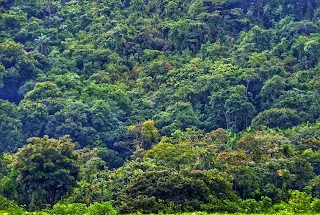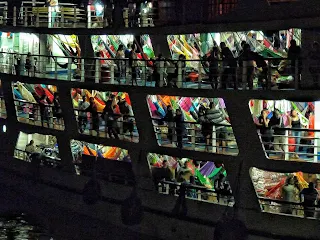BRAZIL (2) - PART FOUR
Manaus, Brazil – Santa Helena, Venezuela
9 January - 24 January 2012
1 162 Kilometres – 15 Days
PHOTOS
E-BOOK
9
January - Manaus – roadside restaurant - 64 km
I
said goodbye to Amanda (who was catching her flight the following day). Then,
Ernest and I headed out of Manaus toward Venezuela. Unfortunately,
we had a slow start as Ernest’s chain broke four kilometres out of town. Significant storm clouds gathered not much later, and it soon started bucketing
down. Not liking how the lightning hit the overhead wires, I thought it best to
take shelter until the worst was over.
The
road north ran through a dense forest on a slightly hilly route. Albeit scenic,
the weather remained sweltering. When the weather came in the second time, a
roadside restaurant with an old chicken shed made an excellent place to set up
camp. The owners didn’t mind and even showed us the shower and toilets. Ernest
swept the chicken shed so we could pitch the tents under cover. The adjacent
restaurant had a reasonably priced buffet, making it a natural choice for
supper.
10
January - Roadside restaurant - Presidente Figueiredo - 67 km
After coffee and getting back on the bikes, it became clear that this was indeed the Amazon basin. Macaws, parrots, lovebirds, and bright blue butterflies kept us company as we climbed hill upon hill. The road led through dense forests and
across countless rivers and ponds that had looked undisturbed for centuries.
A few waterfalls with lovely picnic areas around Presidente Figueiredo looked too
organised for wild camping, so we settled for a room in the hotel instead.
11
January - Presidente Figueiredo – Da Tia Restaurant - 128 km
A
short but hilly section ran to Da Tia Restaurant, where Ernest had previously overnighted
en route to Manaus. The owner (Antonio) was accommodating, and we pitched our tents under a gazebo adjacent to the restaurant. Our early arrival gave Ernest
time to service his bicycle and fix what was broken. The place was lush, and a
short walk through Antonio’s garden revealed loads to eat, including mangoes,
avocados and bananas.
12
January - Roadside restaurant – Petrol station - 76 km
There’s
nothing better than waking to the sound of birds, and being offered a complimentary
breakfast made it the perfect start to the day. Luckily, the weather was
overcast, making the hot and hilly road more bearable. The ride was
incredibly scenic, with lush, green trees and sunlight filtering through the
leaves. I was happy with my decision to bike to the border instead of
taking a bus. I will deal with the visa problem later.
We
continued until reaching a petrol station, which Ernest spotted on his way to
Manaus. It made a perfect place to spend the night as it had a gazebo, showers
and toilets. Later, Ernest cooked pasta, anticipating a long ride the next
day.
13
January - Petrol station – Vila Jundia - 133 km
Six
kilometres after leaving, the road entered the Waimiri indigenous people
reserve. The reserve stretched 120 kilometres, and camping was out of the
question, as even stopping or taking photos was prohibited. Nevertheless, it
remained a stunning ride through virgin forest, but sadly, with no villages or
roadside restaurants to fill our water bottles.
Towards
the end of the reserve, I was delighted to notice a road sign indicating 10
kilometres to Vila Jundia. After a long, hilly, hot day, we left the park
just as the sun started setting. A pousada with tiny, colourful bungalows caught
our attention. It wasn’t inexpensive but also had hot water and air conditioning.
I
couldn’t wait to drag my body into the shower while Ernest rode to the
supermarket and conjured up a pasta dish.
14
January - Vila Jundia – Nova Colina - 98 km
After
eating the leftover pasta with fresh rolls from the bakery, we hopped on our mobile
homes. Our route and the forest flattened out somewhat, but a headwind and the
muddy and potholed road slowed our efforts. Authorities were busy building a
new road; some sections were smooth and paved while others were under
construction.
Shortly
after departing, a sign indicating the equator called for a photo stop. It wasn’t my first time crossing that line, and I was sure it wouldn’t be the last.
Nova
Colina was more extensive than anticipated and revealed a “hotel”, two
supermercados and two bakeries. Nevertheless, Ernest recommended pitching the
tents behind a church with a shelter outback, but I headed straight to the “hotel”.
15
January - Nova Colina – Rorainopolis - 45 km
The
section to Rorainopolis was poor. The route was dusty, hilly and into the wind,
and I was happy to reach this tiny community. Rorainopolis sported
accommodation where we could do laundry and connect to the internet, but the
connection was weak, and too frustrating.
16
January - Rorainopolis – Nova Paraiso - 36 km
Rorainopolis
was barely 36 kilometres from the tiny settlement of Nova Paraiso. Although the
settlement didn’t have anything of interest, neither Ernest nor I felt well,
and on spotting a small pousada hidden behind a petrol station, we called it a
day. Nova Paraiso was hardly a “New Paradise” but an excellent place to
chill.
17
January - Nova Paraiso – Caracarai - 127 km
From
our guesthouse to Caracarai was a long, hot 127-kilometre bike ride.
Fortunately, the route was relatively easy. There wasn’t anything to look at
besides roadworks and a few roadside eateries, and we felt it was best to push
on. Once in Caracarai, Ernest cycled to the supermarket and returned with
ingredients to make a potato salad.
18
January - Caracarai – Mucajai - 87 km
The
dense forest slowly gave way to cattle ranches, and it seemed cattle replaced
the parrots and macaws. Mercifully, the weather was cloudy, which made it easy pedalling.
Mucajai was a tiny settlement that, surprisingly, had accommodation and offered
an internet connection. I spent most of the evening uploading photos and
playing on the internet.
19-21
January - Mucajai – Boa Vista - 63 km
I
was looking forward to Boa Vista and having a day of leisure. Unfortunately,
since the forest had disappeared, it became windier, and we battled into a
headwind for most of the day. As was the norm, accommodation could be found
around the bus station. Boa Vista was a strange town in that the centre was
quiet. The majority of business was around the bus station and outlying areas.
I
thought I could sort out my expired visa in Boa Vista, but I couldn’t find the appropriate
office. I gave up and did laundry instead.
22
January - Boa Vista – Rosa de Saron - 106 km
Cloudy weather, a slight drizzle, and a tailwind made it an easy ride. In the late
afternoon, an undercover spot beside a restaurant provided a place to pitch
the tents. Unfortunately, it was a noisy area where busses and taxis
stopped for snacks and a toilet break.
23
January - Rosa de Saron – Indiu Village- 92 km
Some
days, pedalling is more difficult than others, and this was one of them. It
was scorching and mountainous, and we climbed hill after hill in stifling heat.
I thought I would pass out as I saw black and yellow spots. The road
was exposed, with nowhere to hide.
Eventually,
we reached a small indigenous community that, fortunately, had a good enough
covered area to set up camp.
24 January
- Indiu Village, Brazil – Santa Elena, Venezuela - 40 km
By
early morning, the weather was already boiling. As more hills were waiting, I
left while Ernest was still busy getting ready.
A
slow climb of nearly 1,000 metres in sweltering heat led up the Gran Sabana
plateau, Pacaraima (the border), and Santa Helena in Venezuela. On arriving in
Pacaraima, I bought more Brazilian coffee, which became a favourite during our Brazilian
travels.
Concerned
about my Brazilian visa, which had expired 16 days previously, I wasn’t sure
what the procedure would be. Thank goodness, the fine of 132 reals was only
payable on re-entry into Brazil. That was great news, as the more cash I could
take into Venezuela, the better. At that time, changing money on the street was
twice as good as drawing from the ATM.
Once
immigration was cleared, a short cycle led into the touristy border town of
Santa Helena. The town sported ample accommodation as it was the starting point
for people wanting to climb Mount Roraima. I would’ve loved to have done that,
but Ernest wasn’t one for such ventures.





